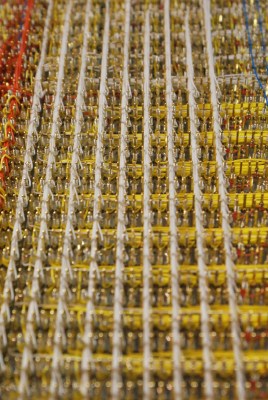…theoretically, anyway. When [Quinn] lucked into a bunch of 5 mm red LEDs and a tube of 74LS164 shift registers, a project sprang to mind: “The Forever Number,” a pseudo-random number generator with a period longer than the age of the universe. Of course, the components used will fail long before the sequence repeats, but who cares, this thing looks awesome!

The core of the project is a 242-bit linear-feedback shift register (LFSR) constructed from (31) 74LS164’s. An XOR gate and inverter computes the next bit of the sequence by XNOR’ing two feedback bits taken from taps on the register, and this bit is then fed into bit zero. Depending on which feedback taps are chosen, the output sequence will repeat after some number of clock cycles, with special sets of feedback taps giving maximal lengths of 2N – 1, where N is the register length. We’ll just note here that 2242 is a BIG number.
The output of the LFSR is displayed on a 22×11 array of LEDs, with the resulting patterns reminiscent of retro supercomputers both real and fictional, such as the WOPR from the movie “War Games,” or the CM2 from Thinking Machines.
The clock for this massive shift register comes from – wait for it – a 555 timer. A potentiometer allows adjustment of the clock frequency from 0.5 to 20 Hz, and some extra gates from the XOR and inverter ICs serve as clock distribution buffers.
We especially love the construction on this one. Each connection is meticulously wire-wrapped point-to-point on the back of the board, a relic originally intended for an Intel SBC 80/10 system. This type of board comes with integrated DIP sockets on the front and wire-wrap pins on the back, making connections very convenient. That’s right, not a drop of solder was used on the board.
You can see 11 seconds of the pattern in the video after the break. We’re glad [Quinn] didn’t film the entire sequence, which would have taken some 22,410,541,156,499,040,202,730,815,585,272,939,064,275,544, 100,401,052,233,911,798,596 years (assuming a 5 Hz clock and using taps on bits 241 and 171 ).
Another LED/LFSR hack we featured used the pseudo-random stream to simulate a flickering candle.















I could have done it with a 555…
oh, wait…
B^)
Check out the gorgeous wire-wrapping job! Link:
https://cdn.hackaday.io/images/3201341546143637768.jpg
This is what a craftsman’s love looks like.
Hey! This is a family orientated website. Get out of here with that pornographic filth! ;-)
yo, i will poke fun at ‘pretty circuits’ all day,when the focus is on aesthetics over function etc, but a sweet wire wrap job like this gets me all hot and bothered!!!! totally does it for me!!! excellent work in design and execution!
Thats beautiful. 555 ? WTsmeg! 7400 and RC. Let it drift. Pixelated Rorshach test with apparent motion. Dont stare at it too long.
That is sex on a stick!
I would end up just sitting there watching it for too long … It kind of reminds me of the circular pov display I once made and one of the first things I did was programmed a pseudo-random number generator to drive the pattern. It was super mesmerizing to just watch it go, all the blue flickering seemingly random patterns and the whur of the motor … getting sleepy just thinking about it …
Now that gives me an idea!
Incorporate a circular POV display into the window of a clothes dryer.
B^)
You could use the data to 3D print snowflakes.
Does anyone know where to find more of these hybrid DIP/wirewrap boards in surplus, or what to search for online to find them? Could be very useful.
Ebay occasionally has them if you search for “wire wrap board”
A completely pointless project with loads of blinking LEDs? Awesome!!!
I mean you could feasibly use it to generate cryptographic keys, but I don’t know if it would be a secure enough pseudo-RNG for that. But you could!
It would be in no way secure. If you can observe one output word, you know exactly what every following output will be.
While an LFSR is a maximal-length PRNG, it is not a CSPRNG because you can derive future outputs from present outputs. The missing ingredient is some hidden state which affects the output but which cannot be derived from the output.
Even the Mersenne Twister is not a CSPRNG.
Wow, I love it.
Now find some pattern that display letters or numbers on the LEDs. Bonus points for current time.
Did anybody implement Conways Game of life using 74s?
Considering how dern long it’ll keep outputting unique and random patterns, I’d be surprised if the works of Shakespeare didn’t appear on that display at some point in the next few hundred trillion years. It would be more likely than not to occur at some point.
Nice. Set up a camera, run some pattern recognition and keep a publicly accessible running log of what words have appeared so far. Beats some speakers in the desert.
“Get them to blink in sequence!”
https://youtu.be/kG-0V-85H_0?t=116
Given enough time, literally ALL possible images and texts will be displayed.
Having formerly done wirewrapping for a living, and hating it with a passion, those photos create deep anxiety. Now I’m going to be having nightmares for days to come!
Me too. I learned in 1966 as an installer for Western Electric. Then intermittently as an engineer at the Air Force Research Lab. About 5 years ago I threw out the last boards like the one in the project. I still have some ww sockets and a whole bunch of prestripped lengths of wire in different lengths, plus some hand wrapping and unwrapping tools. You never know.
Post Wire Wrap Disorder (PWWD)? lol
I used to wire wrap to and I revisited the experience with one project. It was fun for a while and then I remember just how long it takes.
And how long it takes to find a wrap tat’s off by one pin.